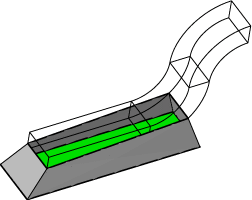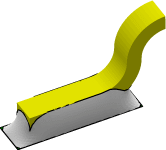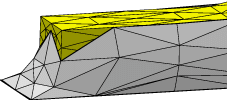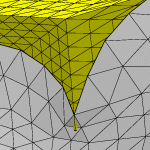Gull Wing home page
Previous Gull Wing page
Next Gull Wing page
Gull Wing Lead Example gullwing-3 for the
Surface Evolver

This file replaces the solder-lead and solder-pad interface
facets with edge integrals for surface energy, gravitational
energy, and volume. This datafile is finally evolvable.
Design steps:
- First, we delete all the interface faces from the datafile, and
the edges and vertices no longer needed. Can't forget to remove
the deleted faces from the body, either. Alternatively, you may
only want to remove faces one by one as they are replaced by integrals.
- In setting up edge integrals, my approach is through direct
slicing arguments rather than a formal Green's Theorem or Stokes' Theorem
approach. That is, I look at the geometry and say this bit of edge
ought to contribute this much to the integral, and write down the
proper formula.
- For the pad contact energy, I choose to slice in y, so each bit
of edge contributes a rectangle from the y axis of area x*dy. From
the orientation of the edges, I see that dy is positive when x is positive,
and the orientation of all the edges is in the same direction all the
way around, so the same integral can be used on all. Multiplying
by the surface tension factor gives the energy integrand
-gamlv*cos(thetap*pi/180)*x*dy.
Note that since thetap was defined in degrees, it must be converted to
radians here.
Adding this to constraint 5 as the energy integrand gives
constraint 5 // pad surface
formula: z = 0
energy:
e1: 0
e2: -gamlv*cos(thetap*pi/180)*x
e3: 0
- For the contact energy on the toe of the lead, I slice in x. The
height of a slice is (z - gap), and dx is positive on this edge (edge 37),
so the area integrand is (z - gap)*dx. Adding the toe surface tension
factor gives this energy integrand on constraint 10:
constraint 10 // toe surface of lead, i.e. -y side
formula: y = leadtoe+leadheel
energy:
e1: -gamlv*cos(theta_toe*pi/180)*(z-gap)
e2: 0
e3: 0
- For the contact energy on the +x side of the lead, I slice in y.
The height of a slice is (z - ZLOWER), where ZLOWER is the height of
the bottom curve of the lead as a function of y. This is a complicated
piecewise defined curve, so I set up some macros for convenience:
#define ZLOWER1 gap
#define ZLOWER2 (orad + gap - sqrt(orad^2-(y-leadheel)^2))
#define ZLOWER3 (gap+(rad+orad)*(1-cos(bend))-rad + \
sqrt(rad^2 - (y-leadheel-(rad+orad)*sin(bend))^2) )
#define ZLOWER ( (y < leadheel) ? ZLOWER1 : \
(y < leadheel+orad*sin(bend) ? ZLOWER2 : ZLOWER3))
Note the parentheses around macros that expand to compound expressions,
so there are no operator precedence problems after expansion. Also note
the line continuation backslashes in multi-line macros; be sure these are
the very last characters on the lines. Using ZLOWER as a function of y
means that things will not be well-behaved if the bend angle were
90 degrees and the solder reach the vertical part of the bend, but
hopefully that combination of circumstances will not arise.
The relevant edge (edge 38) has positive dy, so the area integrand is
(z - ZLOWER)*dy. Putting in the surface tension gives the energy
integrand on constraint 11:
constraint 11 // +x side of lead
formula: x = leadshift + width/2
energy:
e1: 0
e2: -gamlv*cos(theta_side*pi/180)*(z-ZLOWER)
e3: 0
If you consult the datafile, you will see that this is not the final
integrand; gravitational energy will be added below.
- The contact energy on the -x side of the lead follows the same
reasoning, except that dy is negative, so there is a change in sign:
constraint 12 // -x side of lead
formula: x = leadshift - width/2
energy:
e1: 0
e2: gamlv*cos(theta_side*pi/180)*(z-ZLOWER)
e3: 0
If you are wondering why the sign changed here and not on constraint 5 above,
recall that constraint 5 was a single application of Green's theorem, and
here we have two separate surfaces. Also, by checking signs along the
various edges, you see that the chosen signs give the proper results.
- For the contact area on the bottom of the lead, I choose to slice in x.
Thus each slice of area is a thin strip running along the bottom from the
toe up to a bit of edge 39, which is the contact line crossing under the
heel of the lead. Since dx is negative on this edge, the area integrand
is -striplength*dx, which ultimately gives the integrand for constraint 13:
energy:
e1: gamlv*cos(theta_lower*pi/180)*( y < leadheel ? y-leadtoe :
( y < leadheel+(orad+rad)*sin(bend) ?
-leadtoe + orad*asin((y-leadheel)/orad) :
-leadtoe + orad*bend +
rad*(bend-asin((leadheel+(orad+rad)*sin(bend)-y)/rad)) ))
e2: 0
e3: 0
- Now on to the volume corrections. Since the Evolver calculates
body volume with the integral of z dx dy over facets, vertical facets
can be omitted. This leaves just the bottom of the lead.
We could slice in x, but this leads to some pretty messy formulas,
especially in the gravitational energy below. It turns out easier
to slice in y.
For a bit dx dy of the bottom at height z, the bit
of volume is z*dx*dy. We don't have edges
running along the bottom of the lead (well, display edges, but we're
not using those for energy), so we will integrate along the side
edges we do have and use ZLOWER instead of z. And if we integrate the dx
out from the y axis, we get a factor of x, so the integrand becomes
ZLOWER*x*dy. Checking the orientations of the edges, we
see that x*dy always comes out positive, so no sign changes are necessary
on the different edges. However, a further sign check is necessary for
content integrals. The rule is that an edge content integral adds to
a body that has a positive facet with the given edge in positive orientation
around the facet. Our edges are negatively oriented with respect to their
facets, which are positive on the body, so there is an additional negative
sign. Thus the content integrand comes out
content:
c1: 0
c2: -ZLOWER*x
c3: 0
We make this integrand the content integrand
of constraints 11, 12, and 13. Can't forget constraint 13, even though
its edge initially has dy = 0; later on it will not. On the other hand,
constraint 10 edges always have dy = 0, so we don't need to add to that
constraint.
- The gravitational energy works much like volume.
For a bit dx dy of the bottom at height z, the bit
of gravitational energy is G*den*z^2/2*dx*dy. Again, we slice in y and
integrate out dx to get
G*den*ZLOWER^2/2*x*dy. Checking the orientations of the edges, we
see that x*dy always comes out positive, so no sign changes are necessary
on the different edges. So we add this integrand to the energy integrands
of constraints 11, 12, and 13.
- One way to check the values of the individual constraint energies
is to do
convert_to_quantities; show_all-quantities, use
the 'v' command to show the constraint energy values, and compare
with the energies of the facets on the respective constraints in
gullwing-2.fe. For example, for the pad contact in gullwing-2.fe,
Enter command: print sum(facet where on_constraint 5,area*tension)
-301.923239058512
This should be equal to constraint_5_energy in gullwing-3.fe. If they
disagree, find the error in one or the other.
- Actually, the two numbers won't always agree when curved edges
are involved. For those, refine gullwing-2.fe several times to get
better approximation to curves, both for shape and for
numerical integration accuracy.
- G is used in constraint energy formulas instead of mr_grav, so
all gravity can be changed with one 'G' command.
- When the energy is principally surface tension, it turns out the
scale factor is about 0.2 when the tension is 1, and varies inversely
with tension (simple dimensional analysis). Since the tension here is
0.45, we'll raise the upper bound on the scale factor from the default
of 1 to 2:
scale_limit 2
Evolution:

Here is a sequence of evolution commands and some commentary. It is in
the datafile as the "gogo" command.
-
Enter command: l 40
This breaks up the longest edges.
-
Enter command: r
Refine to give some flexibility to the surface.
-
Enter command: g 10
Just to get things started, do 10 gradient descent steps. Things look
good, and the scale factors are nice and large, near 0.2.
-
Enter command: U
Things are going well so far, so we switch to conjugate gradient mode
for faster evolution.
-
Enter command: g 20
 The contact line moves up to the tops of the sides, but way down at
the toe corners. The scale factor gets a little small at the end,
and we notice in the display that there's a skinny triangle we
will have to deal with now.
Two things we could do: vertex averaging to spread the vertices apart,
or delete the skinny triangles. We'll do vertex averaging.
The contact line moves up to the tops of the sides, but way down at
the toe corners. The scale factor gets a little small at the end,
and we notice in the display that there's a skinny triangle we
will have to deal with now.
Two things we could do: vertex averaging to spread the vertices apart,
or delete the skinny triangles. We'll do vertex averaging.
-
Enter command: u;V;u;V
This is a good sequence to use whenever the triangulation gets a
little ugly. It usually gets a nice internal triangulation, but
the edges need a little more help.
-
Enter command: refine edge where valence==1 and not fixed
Introduces more vertices around the edges for a better triangulation.
-
Enter command: g 20; u; V; g 20;
More iteration, with u; V; just on general principles.
-
Enter command: r; V; u; V; u; g 20; V; u; V; u; g 40
Refining, and more evolution. Note the scale factor is often above 1,
which is why we set scale_limit to 2 earlier.
At this stage, you can also see that the contact line on the pad is starting
to round off in the corners. The solder wets all the way into the
corners in the smooth limit only if the contact angle is zero.
- Undercutting
 For some sequences of iterations, a problem can appear on the toe corners.
The surface wants
to suck under a bit. This is a very small effect here, so no action needed,
just keep an eye on it. In the smooth limit, the contact lines will curve to
be tangent to the vertical corner edge, and may go all the way down to
the bottom of the lead. One cure would be to fix the corner point down
at the bottom of the lead. A similar suck under happens on the heel.
For some sequences of iterations, a problem can appear on the toe corners.
The surface wants
to suck under a bit. This is a very small effect here, so no action needed,
just keep an eye on it. In the smooth limit, the contact lines will curve to
be tangent to the vertical corner edge, and may go all the way down to
the bottom of the lead. One cure would be to fix the corner point down
at the bottom of the lead. A similar suck under happens on the heel.
- Enough for this file. For final polishing touches, go on
to gullwing-4.
Forces.
Now that we have a reasonably evolved surface, it is time to
calculate forces on the lead. There are many ways to do this,
as explained in the Ball Grid Array example, but the winner comes
out to be the Principle of Virtual Work. That is, a particular
force is the negative derivative of the energy with respect to
a particular parameter. So one changes the parameter and
recalculates the energy, and does numerical differentiation
to get the force. The nice thing is that the moved surface does
not have to be re-evolved to convergence. Any violation of
the volume constraint can be corrected by using the pressure,
which is the Lagrange multiplier for the volume, which means
that pressure = d(energy)/d(volume).
The force calculations are in a separate file,
gullforces.cmd.
Here's the basic x force calculation command:
dx := 0.0001
calc_xforce := {
delta_x := dx;
move_x;
hi := total_energy - body[1].pressure*(body[1].volume-body[1].target);
delta_x := -2*dx;
move_x;
lo := total_energy - body[1].pressure*(body[1].volume-body[1].target);
delta_x := dx;
move_x;
xforce := -(hi - lo)/2/dx;
}
Because the surface is at equilibrium, the exact way th e surface is
moved does not matter, at least theoretically, but I have chosen to
define a more elaborate move_x command to give a smoother perturbed
surface, which should help with the numerical accuracy, and will
work when the gap is zero. Instead of linearly interpolating between
the pad and the bottom of the lead, I interpolate between the pad and
the lowest point of the contact line on the lead, and store the
interpolation parameter in an extra attribute:
define vertex attribute alpha real
calc_alpha := {
minz := min(vertex where on_constraint 13 or on_constraint 23, z);
if ( minz <= 0.0 ) then
printf "WARNING: contact line hits pad.\n";
foreach vertex vv do
{ if ( vv.on_constraint 1 or vv.on_constraint 5 ) then
{ vv.alpha := 0; continue; };
if ( vv.fixed ) then { vv.alpha := 1; continue; };
vv.alpha := vv.z >= minz ? 1 : vv.z/minz ;
}
}
Then the move_x command becomes
move_x := { calc_alpha;
leadshift := leadshift + delta_x; // do parameters first
set vertex x x+alpha*delta_x;
}
Gull Wing home page
Previous gullwing page
Next gullwing page
Surface Evolver home page
More Surface Evolver examples
Ken Brakke's home page



 The contact line moves up to the tops of the sides, but way down at
the toe corners. The scale factor gets a little small at the end,
and we notice in the display that there's a skinny triangle we
will have to deal with now.
Two things we could do: vertex averaging to spread the vertices apart,
or delete the skinny triangles. We'll do vertex averaging.
The contact line moves up to the tops of the sides, but way down at
the toe corners. The scale factor gets a little small at the end,
and we notice in the display that there's a skinny triangle we
will have to deal with now.
Two things we could do: vertex averaging to spread the vertices apart,
or delete the skinny triangles. We'll do vertex averaging.
 For some sequences of iterations, a problem can appear on the toe corners.
The surface wants
to suck under a bit. This is a very small effect here, so no action needed,
just keep an eye on it. In the smooth limit, the contact lines will curve to
be tangent to the vertical corner edge, and may go all the way down to
the bottom of the lead. One cure would be to fix the corner point down
at the bottom of the lead. A similar suck under happens on the heel.
For some sequences of iterations, a problem can appear on the toe corners.
The surface wants
to suck under a bit. This is a very small effect here, so no action needed,
just keep an eye on it. In the smooth limit, the contact lines will curve to
be tangent to the vertical corner edge, and may go all the way down to
the bottom of the lead. One cure would be to fix the corner point down
at the bottom of the lead. A similar suck under happens on the heel.